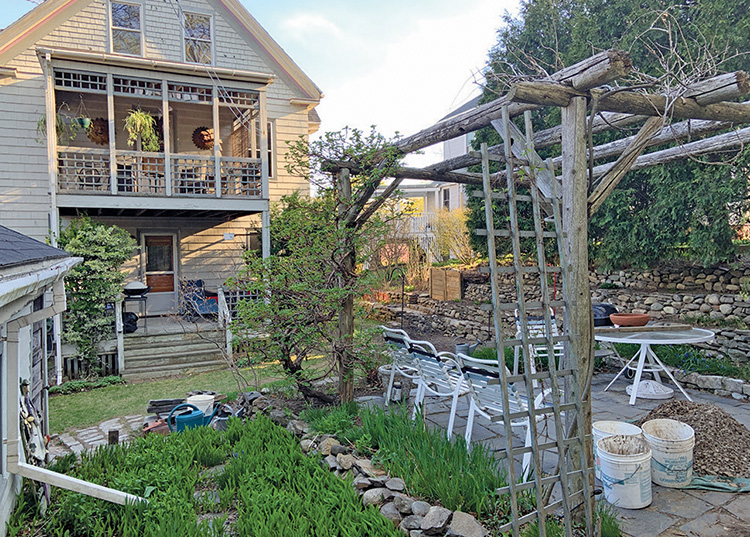
Composting your own food scraps just makes good sense. Economically, you create less trash (and have less to pick up from seagulls ripping into your bags). Environmentally, it’s better for local air quality because most trash in Maine is either burned or put in a landfill, where food scraps release more methane than when they are composted. If you are starting a new garden or yard project this spring, incorporating a composting system into your plans will ensure a steady supply of nutritious soil.
Gregory Adams, a retired social worker who lives in Portland, has maintained his compost pile—as well as his terraced garden, patio and pergola—for close to 30 years. The back deck is the only thing contracted, and he still helped build it. You may have surmised he is my dad, as well.
Adams has spent the last couple of weeks upgrading his composting system’s structure along with several other backyard elements that he has built over the decades at his and his wife’s Oakdale property. The compost pile, tucked out of the porch’s view by a massive yew, is integrated directly into the DIY stone terraces and steps. “It’s a compost sanctuary now,” he said with a laugh. “You can walk up to it and kneel.”

Adams’s two-bin composting system with removable front panels makes turning and aerating an easier process. Photo by Molly Adams
Adams developed his two-bin system design over many years, doing what worked for him as an amateur landscaper and gardener. “Build according to your need,” recommended Adams. “I compost on a big scale because I try to compost as much as possible and have a lot of yard to dress.”
The main advantage of this particular set-up is easy aeration. Maintain moisture balance by keeping one pile active with food scraps, while filling the other with seasonal garden trimmings: grass in summer, leaves in the fall. The sliding panels in the front allow Adams to get all the way to the bottom for turning.
Here’s what also makes Adams’s composting system successful:
It’s in a sunny spot. The heat from the sun helps the compost develop faster.
An open bin aerates naturally. A closed bin contains smell and adds security from pests, but requires more monitoring for correct decomposition. Speaking of pests, be sure to keep food scraps covered with a good layer of brush or grass trimmings. Talk to your local garden store about natural abatement for slugs and mites.
Bones and shellfish scraps are fine, but meat is too heavy for even a large home compost. With the size of his yard, Adams has found more durable scraps can get mixed into the garden when 70% decomposed. Given enough time and space, everything breaks down eventually.
So what’s the next project for Adams?
“I recently retired, so I had planned a number of house projects. But I also planned to travel to break it up and we had to cancel so many trips,” he said. “I’m trying to summon motivation somedays, so I create variety. Now that I’ve done this, I want to build something else new. Maybe a trellis.”
Comments are not available on this story.
Send questions/comments to the editors.


